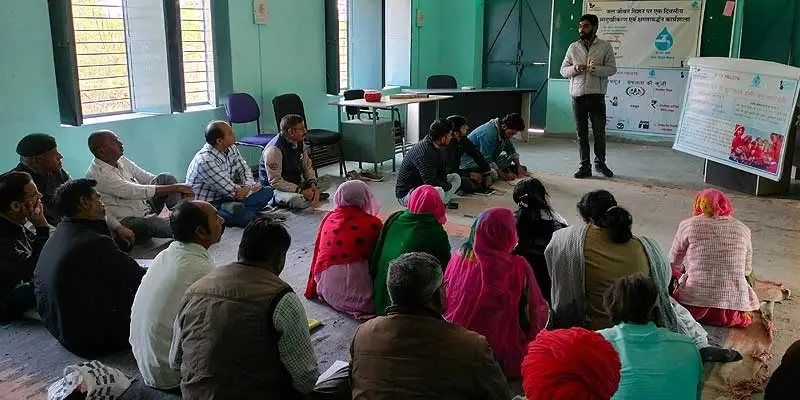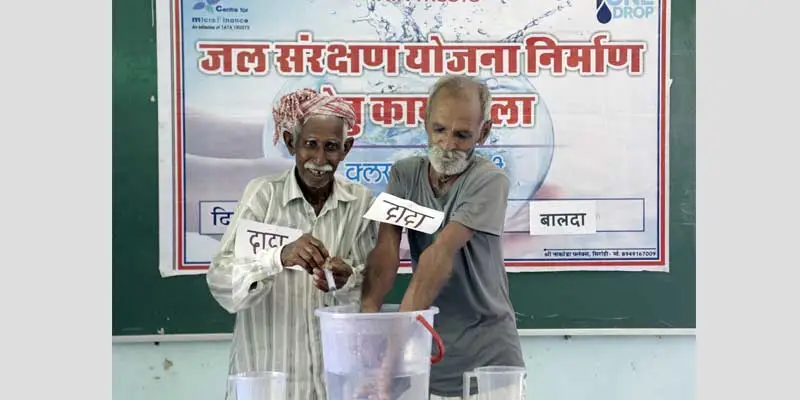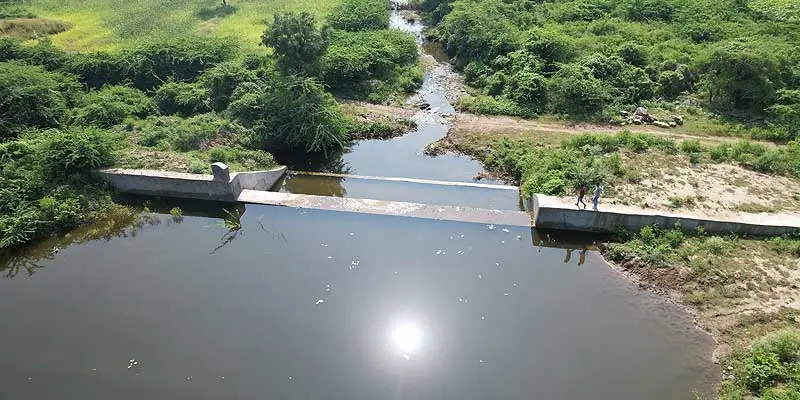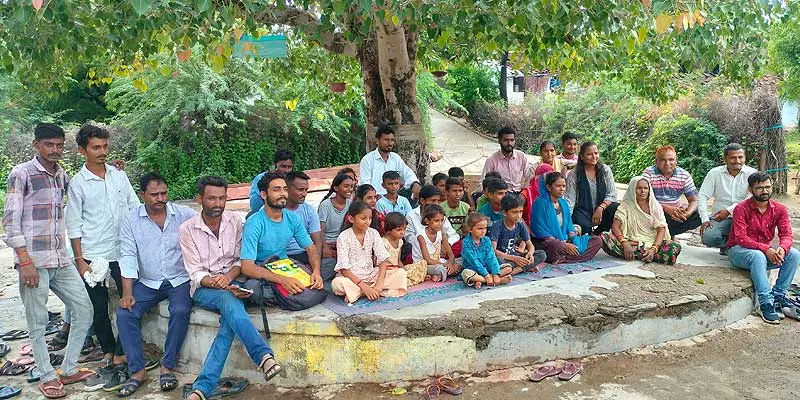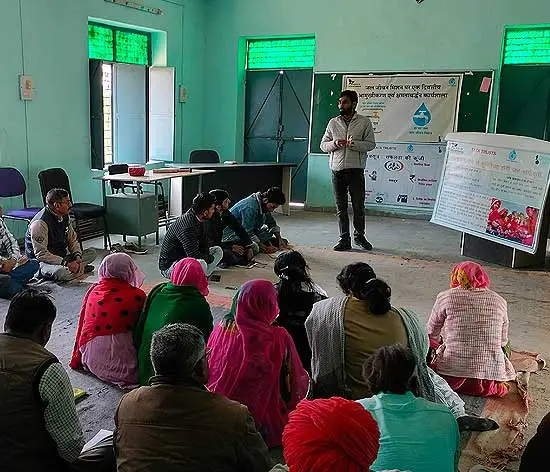
In the heart of Rajasthan’s Sirohi district lies Balda-R village, home to 298 households with a total population of 1,150. The main source of livelihood is farming or manual labour. But in this predominantly hilly terrain with sandy soil, water is a major problem. The arid climate and scanty rainfall also severely impact groundwater availability in the region, raising a critical issue for those who depend on agriculture for their livelihoods. Consequently, about 40% of families have migrated to other regions to seek better job opportunities and economic stability. Of those who remain, only 80 families still engage in farming as their main source of livelihood.
The need of the hour
Recognising the critical need for water management and conservation in the region, the Centre for microFinance (CmF) and Tata Trusts brought Balda-R under its WaSH initiative. Balda-R is one of the many villages from Sirohi and Pali districts that were covered under this initiative, and co-supported by the One Drop Foundation and Crompton CSR Foundation.
The focus of the initiative in these areas was to enhance groundwater availability through water harvesting, conservation, and the promotion of water-efficient agricultural practices crucial to sustain life in arid regions like Rajasthan.
Knowledge is power
As a starting point, CmF organised a three-day workshop on Water Security Planning to raise awareness of the groundwater situation amongst the villagers. Approximately 50 villagers, male and female, actively participated in the discussions, eager to find sustainable solutions.
Over three days, the participants learnt about the state of groundwater in their village and the need for water security. They learnt how to collect detailed information on water usage through a structured questionnaire. Interactive games and data collection exercises helped deepen their engagement with issues of water scarcity.
Activities such as Khooni Khel (a simple, yet interesting gamification tool to ensure community participation) helped them understand how each generation over-extracts groundwater, leaving very little for future generations. It helped them understand the critical need for water budgeting, the process of assessing and balancing available water resources against the disparate demands for water such as agriculture, livestock and domestic demand. They were also taught how to measure rainfall and pump discharge – practical exercises that helped them understand the technicalities of water usage.
Armed with this knowledge, the participants created charts depicting the historical decline in groundwater levels over the past 100 years, and the village’s water consumption. This led to the creation of a jal tula or water balance where the total groundwater was measured against available groundwater. The exercise was a true eye-opener for the villagers who understood that their village was over-exploiting available groundwater, especially for agriculture.
A sense of urgency
Now that they were aware of the seriousness of their situation, the villagers felt the need for concerted action. If they continued their present practices, they would soon face water scarcity year-round. They knew they had to curtail their water usage and harvest rainwater.
The first step was to form a Water Security Committee, comprising 25-30 members from the village, and draft a water security plan that was submitted to the Gram Panchayat for approval. A few members emerged as leaders. They were proactive in planning and taking the responsibility of collecting and disseminating information about available government-endorsed water-saving technologies. They also helped to educate their community about government schemes related to the construction of drains, ponds, anicuts and check dams for rainwater harvesting.
The comprehensive one-year water security plan included demand-side management to enhance irrigation efficiency in agriculture through practices such as micro-irrigation, natural farming practices, change in cropping patterns, etc., and supply-side management that included development of recharge and harvesting structures.
Swinging into action
The Water Security Committee identified an anicut in the catchment area, which needed to be renovated. With the help of CmF, they also identified suitable sites for levelling. The renovation cost was shared between the community (5%) and CmF (95%). In addition, the Panchayat provided the resources for clearing the site around the anicut as well as for Naadi excavation. The renovation of the anicut was completed in March 2024, while the land levelling followed.
The renovation of the anicut has created a storage capacity of approximately 1.6 crore litres of water. This is sufficient to meet the annual domestic needs of approximately 798 people based on standard consumption rates.
The anicut benefits eight open wells and six bore wells situated near the structure. The structure ensures the sustainability of two drinking water sources; one that is currently supplying piped water to 150 households through an existing Panchayat scheme, and the second, an under-construction source that is part of the Jal Jeevan Mission (JJM) scheme and will eventually provide piped water to all the households in the community.
On the demand side, a tailored strategy was developed to limit the over-extraction of water. Since it wasn’t feasible to shift all the farmers from flood irrigation to drip irrigation, it was decided that farmers with larger landholdings and who voluntarily opted for sprinkler irrigation would adopt these measures. Others would implement alternative methods designed to yield long-term benefits such as increased soil health and reduced groundwater extraction.
Out of the 40 farmers who adopted micro-irrigation, 25 have already implemented the method over 14 hectares of land. Previously, these 25 farmers were using flood irrigation, consuming 7.7 crore litres of water; using a sprinkler system primarily for wheat and mustard crops has reduced water consumption to 4.23 crore litres. This method has also enabled them to save time and labour.
A visible impact
Two members of the Balda-R Water Security Committee voluntarily stepped forward to become ‘Pani Mitras’, guiding their communities towards sustainable water management. Forty-year-old Nain Singh has already made significant improvements in his farming practices over his 15 bighas of land. He has installed sprinklers in 5 bighas that has netted him an annual savings of approximately ₹9,000 to ₹10,000 in labour costs. He has reduced water usage by cutting down pumping hours from 1 to 1.5 hours per bigha. The water saved is now used to grow fodder, which supports his livestock, eliminating the need to purchase feed.
He also used the excavated soil from the anicut construction site to prepare 1.5 bighas of unused land for agriculture. All these initiatives coupled with mixed cropping methods (mustard, green gram and maize) during the Rabi and Kharif seasons have allowed him to earn a profit of approximately ₹20,000.
Similarly, 52-year-old Mohan Singh, who owns 13 bighas of land, installed sprinklers on four bighas. This saved him around ₹8,000 in labour costs and reduced pumping hours. Like Nain Singh, Mohan also used the surplus water to grown animal fodder and vegetables for domestic consumption. Using the excavated soil from the anicut site, Mohan also prepared 1.5 bighas of previously unused farmland to plant maize in the Kharif season. His efforts have netted him a profit of approximately ₹17,000. In addition, he planted ten trees on his field to enhance environmental sustainability.
These are just two examples. These collective efforts reflect the community’s dedication to sustainable and water-efficient agricultural practices. Emboldened by the visible impact of their efforts, the community is now moving forward to ensure the strategic use of water and best practices in agriculture. By incorporating innovative irrigation methods, selecting appropriate crops, adopting organic farming techniques and undertaking targeted water harvesting initiatives, the villagers of Balda have established a sound foundation towards sustainable agriculture and sensible water use.
Balda is an inspiring example of how perseverance, determination, and collaboration can work wonders to surmount obstacles.
